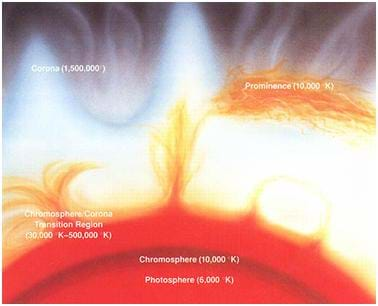
It is also, and fortunately, the region from which we can obtain the most detail about the detailed properties of the corona using spectroscopic techniques. The E-corona only extends about 700,000 km from the photosphere, but this region includes the majority of the bright corona that you see during a total solar eclipse. With suitable instruments, they can even be used to measure the strength of the magnetic fields through which they move. Based upon these lines, astronomers can identify which elements are present in the coronal gas, the temperature of this particular ionic species, how fast clouds and other structures are moving, and the density of this gas. Because no two atoms and ions have exactly the same set of electronic transitions, each ion emits a unique pattern of spectral lines, which can be detected with a spectroscope. The E-corona represents the light from ions in this plasma that absorb light from the photosphere and re-emit it through specific electronic transitions between energy levels in these ions.
Sun corona temperature celsius free#
This means that the coronal gas is a high-temperature plasma consisting of numerous free electrons and the ions of many kinds of atoms. Although hydrogen is completely ionized into free protons and electrons, other common elements such as oxygen, nitrogen and iron are not completely stripped of all their electrons. The corona is a dilute ‘upper atmosphere’ to the sun in which atoms become ionized at temperatures above 1 million Celsius. To understand these regions, we have to understand how matter and radiation interact. The E-corona is the weakest of the three within twice the sun’s radius and is generally not observable except by using a spectroscope, but more on that later. Even during a total solar eclipse, we see that the K-corona outshines the F an E coronas at distances closer than about twice the solar radius, but at greater distances it is the F-corona that completely dominates. Also is the brightness of the clear desert sky, and the sky during a total solar eclipse. The figure shows then brightness of the major K, F and E corona components in terms of their distance from the sun in units of the sun’s radius, and the intensity of the corona in terms of the brightness of the sun’s photosphere.


To distinguish them they are called the K-corona, E-corona, F-corona, T-corona and the S-corona after ‘Kontinuierlich’ (Continuum), Emission, Fraunhofer, Thermal and Sublimation. But how does the corona shine? In fact, there isn’t simply one corona emitting light but five different solar corona, each produced by different light-emitting processes. Such surfaces emit electromagnetic radiation in the visible part of the spectrum near what the human eye and brain identify as the color yellow. We know that the sun shines because its surface has a temperature of 6000 Celsius.


 0 kommentar(er)
0 kommentar(er)
